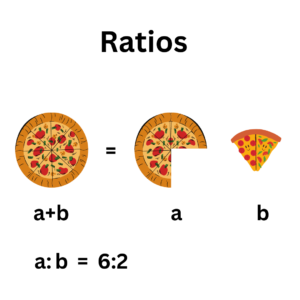Introduction
Ratios are said to be equivalent if they can be made simpler or reduced to the same number. In other words, a ratio is said to be equivalent if it can be expressed as a multiple of another ratio.
A ratio can be expressed using a fraction. The concept of an equivalent ratio is comparable to the concept of equivalent fractions. The antecedent and consequent of a ratio can be multiplied or divided by the same number, other than zero, to create an equivalent ratio.

To get a ratio that is equal to the given ratio, we must first represent the ratio in fraction form. Then, by multiplying or dividing the first term and second term by the same non-zero value, the equivalent fraction can be found. We finally convert it to a ratio.
What are Equivalent Ratios
We must first comprehend what equivalence is to understand the equivalence of ratios. Equivalence is very similar to the well-known mathematical relation equal to, as well as to the same mathematical relationship between different objects. In mathematics, equivalence refers to the concept that two objects are equal but distinct because they have the same overall value. When two ratios share the same simplest form, they are said to be equivalent.
Examples of Equivalent Ratios
We can simply create equivalent ratios by multiplying the antecedent and consequent of a ratio by any real number other than the number zero. Thus, creating some examples of equivalent ratios is a very simple task.
For example, we need to find 5 ratios equivalent to 6:10
We can multiply the given ratio by any real number, let’s multiply it by ½
6: 10 = ![]() = 3: 5
= 3: 5
Thus 3:5 is a ratio equivalent to 6:10
Other such ratios are, 9:15, 12:20, 15:25, 18:30, etc. these all are ratios equivalent to 6:10.
Methods of Finding Equivalent Ratios
There are two methods to find the equivalence of ratios, these methods are
-
Cross Multiplication Method
In this method, we multiply the antecedent of the 1st ratio with the consequent of the 2nd ratio and the antecedent of the 2nd ratio with the consequent of the first. If the two products are equal then we can say that the two ratios are equivalent, otherwise, the ratios are not equivalent.
For example: Let’s say we need to use the cross-multiplication method to determine whether the ratios 3:4 and 6:8 are equivalent.
Therefore, we will multiply each ratio’s antecedent by the other ratio’s consequent.
We can say that the ratios are equivalent if the two products are equal.
In this example: 1st Product
3 × 8 = 24
2nd Product
6 × 4 = 24
Since,
Product 1 = Product 2
The ratios 3:4 and 6:8 are equivalent.
-
HCF Method
In this method, we first need to represent the ratios as fractions, then we will reduce that fraction into standard form by finding the HCF of the numerator and the denominator, and then dividing the numerator and denominator by that HCF. After both fractions are reduced to the standard form, if they are equal, then the original fraction, i.e., the ratios were equivalent.
For example: Let’s say that we need to use the HCF method to determine whether the ratios 4:14 and 6:21 are equivalent.
To divide the antecedent and consequent of both ratios with their respective HCFs, we will first check the HCF of the antecedent and consequent for each ratio. If the two ratios are equal after the division, the original ratios were equivalent.
In this example: 1st ratio
4:14
HCF (4, 14) = 2
The ratio in the simplest form,
4: 14 =![]() = 2: 7
= 2: 7
2nd ratio
6: 21
HCF (6, 21) = 3
The ratio in the simplest form
6: 21 = ![]() = 2: 7
= 2: 7
Since both ratios in their simplest forms are 2:7, thus the original ratios were equivalent.
Use of Equivalent Ratios
In mathematics and other sciences, equivalent ratios have many applications. Some examples of uses are:
- To make the ratios provided simpler.
- We use equivalent ratios to solve any ratio-related problem.
- To calculate ratios between various fractions.
- Various direct proportionality-related scientific issues.
There are also a lot more uses like this.
Read: Applications of Percentage
Summary
We learned about the circumstances under which ratios or proportions are equivalent in this article. We discussed a few instances of equivalent ratios. The following ideas we learned were how to find equivalent ratios. We also discovered how ratios are equivalent using these techniques. Last but not least, we solved several cases that illustrated the concept of equivalent ratios.
Frequently Asked Questions
1. What are Ratios? What are the Components of Ratios?
Ans: Ratios are defined as a comparison between two quantities of the same type. A ratio has 3 parts, 2 parts are the numbers representing the compared quantities antecedent and consequent, and the third part is a symbol, specifically the ‘:’ (colon) symbol, that is put between the two to represent the comparison.
2. Why are Equivalent Ratios Important?
Ans: The equivalent ratios can be used to explain certain relationships between objects in daily life. For instance, if two pens cost Rs. 10, we can use equivalent ratios to determine the price of any other number of pens or the number of pens that can be purchased with a given sum of money. Many other real-world issues can be resolved using equivalent ratios.
3.What are Proportions? What is the Symbol of Proportions?
Ans: Proportions are a comparison between two or more ratios. If two ratios are in proportion, then they are also equivalent.

